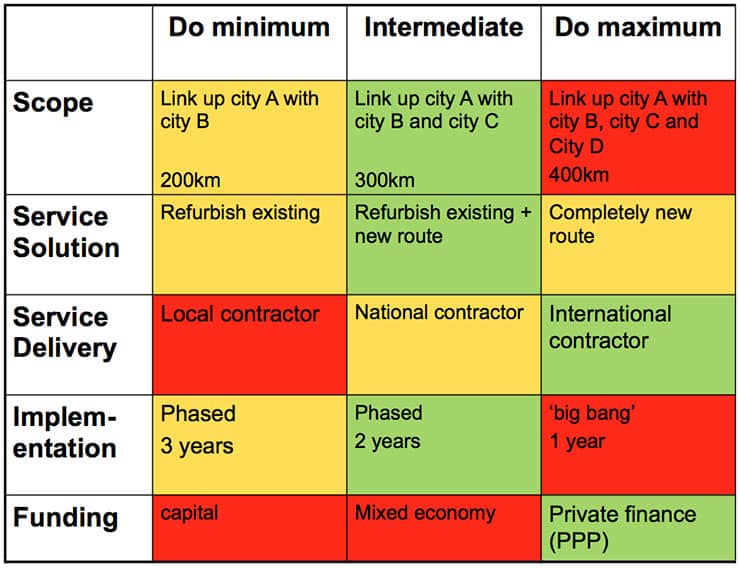The Options Framework is a structured brainstorming technique you can use with groups of up to 7 people to get a preferred solution to a difficult problem.
This technique gives you a preferred way forward, a more ambitious solution, a conservative solution and the narrative behind your journey that can be explained to a board or steering committee.
Objective
- To brainstorm and achieve consensus on a preferred solution to a difficult problem ready for more detailed economic and financial analysis.
When Would You Use It?
- Any time you need to brainstorm a long list of solutions to a problem that you would like to reduce down to a more focused short list before doing more detailed economic and financial analysis.
Are There Any Rules?
- Draw the framework on a whiteboard or use post-it notes so you can rub ideas out and swap them with new ones easily. People changing their minds should be encouraged as it’s part of the process.
- Don’t try and run this with any more than 6 or 7 people. Any more than that and you get stuck talking with little action.
The Options Framework Questions
SCOPE – What is the potential service coverage?
SERVICE SOLUTION – How are you going to create the solution?
SERVICE DELIVERY – Who is going to deliver the solution?
IMPLEMENTATION – When are you going to deliver the solution? How quickly? Will it be phased?
FUNDING – How are you going to pay for the solution?

The Options Framework triangle
Process
- Agree with the group what the current situation is.
- Get a shared understanding of what the ‘status quo’ is (i.e. if we do the absolute bare minimum after we walk out this room what would that be?).
- Get a shared understanding of what your spending objectives are. These should be SMART objectives (Specific, Measurable, Achievable, Realistic, Timely).
- Get a shared understanding of what the outcomes will look like at the end of the project (e.g. “we need to educate 400 under 11 year olds every year in our geographical region” and NOT “we need to build a school”).
- Complete the top row (scope) first and work down the grid in order. This is important because each row informs the choices in the next row.
- Ask what the least ambitious scope might be – what would the solution look like if we were conservative? (e.g. narrow coverage of services).
- Ask what the most ambitious scope might be – what would the solution look like if we did more? (e.g. wide coverage of services).
- Ask what an intermediate scope might be – somewhere in between least ambitious and most ambitious.

- As you work through each row, select a preferred solution for that row and color it green.
- Ask the group if any of the options are impossible (and color them red).
- Color the rest yellow (i.e. these are possible in that they are more ambitious if they are to the right of the green and more conservative if to the left).
- Repeat for each row as you work down the table.

- Allow the group to go back and change parts of the solution if they’d like to (it’s all part of the process).
- At the end of the session write-up the narrative of the session that supports the decisions taken in creating the framework.
Secret Sauce
- It’s essential to get all the right people in the room. It’s especially important you have a group who can give you informed views on the subject your tackling.
- Depending on the complexity of the problem to be solved this could be one workshop with a small group of key stakeholders or a series of several workshops with many stakeholders.
- The important thing is being able to explain the decisions you’ve made as a group at the end so record the narrative as you go.
- Run it with a co-facilitator so they can record the narrative while your leading the process.
- Don’t try and go down into too much detail too early. This depends on the level you’re using it at. The process and tool can be used at the strategic level (keep very high level), programme level and project level.

